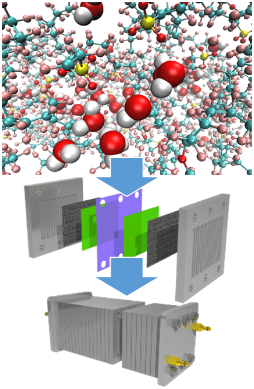Fuel cell group

Proton Exchange Membrane Fuel Cells (PEMFCs) are spreading to realize the hydrogen energy based society. The mass transport in the cell is one of the important problems to improve cell performance. Optimization of the system requires to elucidate the transport phenomena of proton, oxygen, and water in the cell. Cell components such as polymer electrolyte membrane, catalyst layer, and microporous layer have nanoscale structures. Experimental measurements have not been completely interpreted in terms of the molecular level transport phenomena. Thus, the numerical simulations are effective method for the clarification of mass transport in nanoscale structure. In Tokumasu laboratory, atomic/molecular simulations have been performed to investigate the mass transport in PEMFCs. Supercomputer in IFS (AFI-NITY) allows us to elucidate the relationship between the structural properties of each component and the transport phenomena in the cell.
double_arrow What is a fuel cell?Research theme
Reactive molecular dynamics approach for the characterization of proton transport ans water clustering in polymer electrolyte membranes
Oxygen transport analysis based on the gas-surface interaction in the catalyst layer.Multiscale simulation of proton transport in the catalyst layer.
Influence of cerium ions on mass transport properties in polymer electrolyte membranes.
Numerical analysis of nanostructure around ferrous ion in hydrated Nafion membrane. Structural effect of ionomer on oxygen permeation properties. Molecular dynamics study of transport properties in degraded Nafion membranes.Secondary battery group

In recent years, as energy demand has increased and environmental problems have become more serious, new energy production technologies that do not use fossil fuels have been demanded. Today, the term “best mix of energy” has come to be seen in various scenes, and energy development with more efficient and less environmental impact is being promoted by combining various power generation methods. In the automobile industry, regulations on CO2 emissions and fuel consumption of automobiles are expected to be strengthened in major countries in the future, and nitrogen oxide emissions are becoming extremely severe worldwide due to regulations such as Euro 6 in Europe. In the 21st century, the information society will change further, and mobile communication power supplies such as mobile phones and personal computers are required to have higher energy density and smaller size. In other words, it is no exaggeration to say that one of the solutions to the energy problem in the 21st century depends on the development of a new battery that can store electricity without emitting CO2 or nitrogen oxides. Therefore, secondary batteries that can be charged and discharged and do not emit CO2 or nitrogen oxides are attracting attention.
Research theme
Molecular dynamics analysis of electrical transfer phenomenon of C atom in Fe
Semiconductor group
Semiconductor integrated circuits (IC) are used in many applications such as communication equipment, home appliances, and automobiles to support modern life. The importance of IC is increasing year by year with the spread of IoT (Internet of Things) and AI (Artificial Intelligence), and the use of big data and the cloud. There are multiple processes in semiconductor manufacturing such as deposition, etching, cleaning and, interconnect formation. For advanced semiconductor devices, controls on the atomic layer level with a thickness error of ± 0.5 Å on the wafer is required for the deposition process. Chemical vapor deposition (CVD) and Atomic layer deposition (ALD) are widely used as deposition techniques to meet advanced demands. However, it is difficult to understand the deposition mechanism that includes dynamics and chemical reaction clearly by experiment only. Therefore, in our lab, reactive force field (ReaxFF) molecular dynamics simulation and quantum chemical (QM) calculation are used to understand deposition mechanisms.
